A Different Way of Listening
When we listen, we tend to listen for something—something to respond to. We listen for an idea we like or dislike, or an experience we can relate to. We listen to provide support and affirmation. We listen for the hook that either engages us and draws us in, or repels us and pushes us back. We listen ready to react.
This kind of listening makes sense in a formal debate, in which two sides are arguing opposing points and listening for weaknesses and opportunities in the statements of the other side. But such an approach constrains real dialogue, where the intent is to create connection and expand understanding.
We naturally process what we hear through our own framing and experiences. We hear what is important to us and ignore that which does not resonate. It is like being given a picture and cropping out what is irrelevant—to us. But it might be essential to the speaker.
A perfect example is when Mary Kissel of the Wall Street Journal interviewed Robert Murray of the Frontier Centre for Public Policy, a conservative think-tank based in Alberta, shortly after Justin Trudeau was elected Prime Minister of Canada in October 2015. She kept framing her questions in terms of taxes even though he repeatedly replied that this election was more about values. They were like ships passing in the night—purportedly in the same conversation, but actually not. Her questions were entirely through her frame of reference, which yielded little of value. If she had engaged in more open inquiry (“What do you mean?”) it would have offered greater insights.
Other examples are from our everyday lives, when talking with friends or colleagues. We quickly exclaim: “I know just what you mean!” when in reality we may not fully understand. Or we try to offer comfort for emotional distress by putting it in a different context (“It’s not really that bad; look at it this way…”). Instead, we can simply say: “You are sad about “x” situation; what does that mean for you?”
Jesper Juul, a Danish child-development specialist, makes this same point in reference to children’s drawings. When we say to a child: “What a beautiful/cool picture you have drawn!” we are unconsciously judging both the picture and the child’s capabilities. Instead, Juul suggests that we acknowledge the picture and ask neutral questions: “I see you have drawn a picture. Tell me about it; what is it about?” Not only is this what every child needs to hear; it is what every one of us needs to hear. We want someone to simply hold the space so we can express ourselves from the context we inhabit.
Transformative listening means having an awareness of the frame of reference we bring to the table, and the humility to set it aside temporarily. It means cultivating openness and inquiry, sitting with ambiguity, and letting clarity come slowly. While this approach may not be relevant to every situation, it is applicable to many. It transforms the meaning and trajectory of an interaction and gives rise to new understanding.
I often find it challenging to listen this way because I love to jump in with my thoughts and perspective, but it gets easier with practice. I keep at it because it gives me more interesting conversations. Try it and let me know what you think.
———
Copyright © 2018 Sharon V. Kristjanson. All rights reserved.

